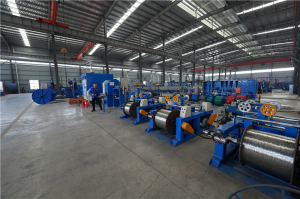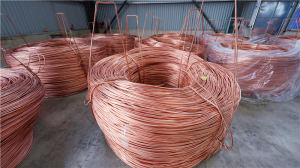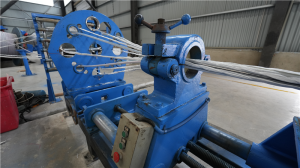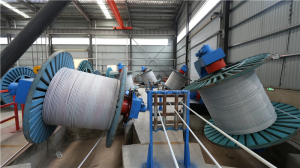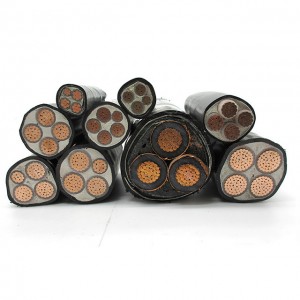Wires and cables use length as the basic unit of measurement. All wires and cables start from conductor processing, and then add insulation, shielding, cabling, sheathing, etc. layer by layer on the periphery of the conductor to make wire and cable products. The more complex the product structure, the more layers are superimposed.
Wire and cable production process
1. Copper, aluminum monofilament drawing
Commonly used copper and aluminum rods for wire and cable, at room temperature, use a wire drawing machine to pass through one or several die holes of the drawing die to reduce the cross section, increase the length and improve the strength. Wire drawing is the first process of each wire and cable company, and the main process parameter of wire drawing is mold matching technology.
2.Monofilament annealed
When the copper and aluminum monofilaments are heated to a certain temperature, the toughness of the monofilaments is improved and the strength of the monofilaments is reduced by means of recrystallization, so as to meet the requirements of electric wires and cables for conductive cores. The key to the annealing process is to prevent the oxidation of the copper wire.
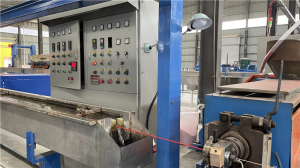
3. Stranding of conductors
In order to improve the softness of wires and cables and facilitate laying and installation, the conductive core is twisted with multiple monofilaments. From the stranding form of the conductive core, it can be divided into regular stranding and irregular stranding. Irregular stranding is divided into beam stranding, concentric stranding, special stranding, etc.
In order to reduce the occupied area of the wires and reduce the geometric size of the cable, the compact form is adopted while the conductor is stranded, so that the ordinary circle is mutated into a semicircle, a fan shape, a tile shape and a tightly pressed circle. This type of conductor is mainly used in power cables.
4. Insulation extrusion
Plastic wire and cable mainly use extruded solid insulation layer. The main technical requirements for plastic insulation extrusion:
4.1 Eccentricity: The deviation value of the extruded insulation thickness is an important symbol reflecting the level of extrusion technology. Most of the product structure size and its deviation value are clearly stipulated in the standard.
4.2 Smoothness: The surface of the extruded insulating layer is required to be smooth, and there must be no poor quality problems such as surface roughness, burnt, and impurities.
4.3 Density: The cross-section of the extruded insulating layer should be dense and firm, without pinholes visible to the naked eye, and to prevent the existence of air bubbles.
5. Cabling
For multi-core cables, in order to ensure the degree of formability and reduce the shape of the cables, it is generally necessary to twist them into a circular shape. The mechanism of stranding is similar to that of conductor stranding. Due to the large pitch diameter of stranding, most of them adopt the non-back twisting method.
Technical requirements for cabling: one is to prevent twisting and bending of the cable caused by the overturning of special-shaped insulated cores; the other is to prevent the insulation layer from being scratched.
Most of the cables are cabled together with the completion of two other processes: one is filling to ensure the roundness and stability of the cable after the cable is formed; the other is binding to ensure that the cable core is not loose.
6. Inner protective layer
In order to protect the insulated wire core from being damaged by the armor, it is necessary to properly protect the insulation layer. The inner sheath is divided into: extruded inner sheath (isolation sleeve) and wrapped inner sheath (cushion). The wrapping cushion replaces the binding tape and the cable-forming process is carried out simultaneously.
7. Armor
The cables laid underground may bear a certain amount of positive pressure during work, and the inner steel tape armored structure can be selected. When the cable is laid in the occasion with both positive pressure and tension (such as in water, vertical shaft or soil with large drop), the structure type with inner steel wire armor should be selected.
8. Outer sheath
The outer sheath is a structural part that protects the insulation layer of the wire and cable from environmental factors. The main function of the outer sheath is to improve the mechanical strength of the wire and cable, chemical corrosion resistance, moisture resistance, water immersion, and the ability to prevent the cable from burning. According to the different requirements of the cable, the plastic sheath is directly extruded by the extruder.
Email: sales@zhongweicables.com
Mobile/Whatspp/Wechat: +86 17758694970
Post time: Mar-22-2023

